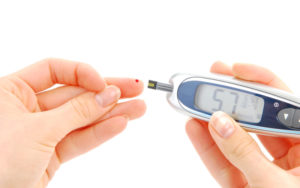There are different types of diabetes. Most people first think of diabetes type 2, or adult-onset diabetes, which usually develops later in life and is medically treated with Metformin. However, there is also diabetes type 1, or juvenile diabetes, which is usually diagnosed in childhood and is medically treated with insulin. In addition, scientists have learned that people who have a combination of diabetes type 1 and type 2 have striking similarities to Alzheimer’s disease. In fact, there is such a strong connection between diabetes and Alzheimer’s disease that scientists have contemplated renaming Alzheimer’s disease to “diabetes type 3.”
 Diabetes type 1, or juvenile diabetes, is an autoimmune disease. Autoimmune disease is when the body’s immune system is so overactive, it can cause harm to the body. Other examples of autoimmune diseases, which can help in the same way as diabetes type 1, include Hashimoto’s disease, Sjogren’s disease, rheumatoid arthritis, multiple sclerosis, Grave’s disease, lupus, psoriasis, fibromyalgia, and celiac disease. In reference to juvenile diabetes type 1, or autoimmune diabetes, the pancreas is affected and the body produces longer-release insulin. Because of this, doctors say it is important that meals match insulin doses. Diabetes type 1 affects the pancreas and insulin, but autoimmune diseases can also affect organs like the thyroid, the brain, the stomach, the skin, the muscles, and the joints.
Diabetes type 1, or juvenile diabetes, is an autoimmune disease. Autoimmune disease is when the body’s immune system is so overactive, it can cause harm to the body. Other examples of autoimmune diseases, which can help in the same way as diabetes type 1, include Hashimoto’s disease, Sjogren’s disease, rheumatoid arthritis, multiple sclerosis, Grave’s disease, lupus, psoriasis, fibromyalgia, and celiac disease. In reference to juvenile diabetes type 1, or autoimmune diabetes, the pancreas is affected and the body produces longer-release insulin. Because of this, doctors say it is important that meals match insulin doses. Diabetes type 1 affects the pancreas and insulin, but autoimmune diseases can also affect organs like the thyroid, the brain, the stomach, the skin, the muscles, and the joints.
Since autoimmune disease results in the body “attacking” itself, one way to help is to work on decreasing the overactive immune system and not being so sensitive to foreign invaders. Modern research has shown the most effective way to do this is through an autoimmune elimination diet. This is quite involved, but the basics are to eliminate all grains, dairy products, corn, soy, alcohol, and coffee. Some of these food products have certain proteins or that activate an immune response, so many functional medicine doctors recommend avoiding them completely. It is also important to eliminate chemicals, as well, so eat organic and avoid preservatives, deli meats, food dyes, artificial flavors, and sugar replacements, especially in diet soda and drinks. Now, with Covid-19, we are exposed to more chemicals than ever, especially with all the cleaning products and disinfectants, so be careful not to overdo it, and open up all your windows after cleaning.
 In addition, it is important to avoid foods with a high glycemic index like soda, lemonade, bread, pasta, chips, cookies, and pastries. People with diabetes type 1 should avoid all trans fats, hydrogenated foods, and high-fat animal products, as well. The top five foods that are extremely beneficial and helpful for diabetes type 1 are sardines, vinegar, cinnamon, berries, and fresh vegetables. It is also better for diabetes type 1 patients to not go too long without eating to avoid hypoglycemia. Also, diabetes type 1 people should eat protein meals such as beans, fish, and lean meat with a side of vegetables and lots of salad. It is important for diabetics to carry around snacks such as nuts, carrots, or strawberries, and not go long hours during the day without eating. If your fasting blood glucose levels are low, or you are hypoglycemic, it is best to snack frequently between meals, and not go longer than 2-3 hours without eating something.
In addition, it is important to avoid foods with a high glycemic index like soda, lemonade, bread, pasta, chips, cookies, and pastries. People with diabetes type 1 should avoid all trans fats, hydrogenated foods, and high-fat animal products, as well. The top five foods that are extremely beneficial and helpful for diabetes type 1 are sardines, vinegar, cinnamon, berries, and fresh vegetables. It is also better for diabetes type 1 patients to not go too long without eating to avoid hypoglycemia. Also, diabetes type 1 people should eat protein meals such as beans, fish, and lean meat with a side of vegetables and lots of salad. It is important for diabetics to carry around snacks such as nuts, carrots, or strawberries, and not go long hours during the day without eating. If your fasting blood glucose levels are low, or you are hypoglycemic, it is best to snack frequently between meals, and not go longer than 2-3 hours without eating something.
Diabetes type 1 is an autoimmune disease, and diabetes type 2 is a condition that affects the production of insulin. Fortunately, diabetes type 2 can usually be avoided with a little prevention by way of simple lifestyle changes. Making these changes might seem difficult at first, but will quickly provide you the benefit of feeling better and stronger. The first step you should take to prevent diabetes type 2 is to get a full blood panel. Another proactive step you can take to prevent diabetes is making a commitment to intermittent fasting. This has been clinically proven to reduce diabetics’ numbers. Intermittent fasting is easy – you only eat between the hours of 9 a.m. and 5 p.m. every day. In the hours before and after, you can drink water to stay hydrated. It is important that you are not working or doing strenuous activities during your fasting times so you do not risk passing out. For example, if you are a nighttime worker, you will need to eat at night to give your brain and body the energy it needs to work so fasting from 5 p.m. to 9 a.m. would not be appropriate. Additionally, consider avoiding all electronic devices for the 4 hours before bedtime to regulate your sleep cycle. This helps reduce the body’s release of the stress hormone cortisol. When too much cortisol is released at night, it can create belly fat, as well, putting you more at risk for Covid-19. So ideally, you are eating from 9 a.m to 5 p.m., you are done with electronics by 6 p.m., and are sleeping from 10 p.m. to either 5 a.m. or 6 a.m.
Everyone, not only diabetics, should avoid refined carbohydrates, sugar, high fructose corn syrup, and sugar replacements. Instead of having cake or candy to satisfy your sweet tooth, try switching to fruit like bananas or apples which also have dietary fiber, vitamins, and minerals.
There is more to preventing diabetes than just diet. Reducing stress in your life is another important skill that is significant in diabetes prevention. Most of us have busy lives. We need to react to our schedules and stressful circumstances in healthy ways. Exercise or meditation classes along with pilates or yoga can help us look at our lives with a new, healthier perspective – positivity and calmness – which lets our bodies function the way they’re supposed to.
 Now we said before that if you have a combination of both diabetes type 1 and type 2, then not only are your chances of developing Alzheimer’s much higher, but also your chances of getting Covid-19 are higher as well. Remember that if you have obesity, diabetes, or heart disease, your odds of a poor outcome from a coronavirus exposure greatly increase. Therefore you must do whatever you can to prevent diabetes. This also includes physical exercise. You must keep your body moving. It is very important not to sit for too long, so start practicing the “20 Rule.” Every 20 minutes, get up for 20 seconds and move your body for 20 seconds. This is great for the brain and the body. Also, start finding exercise groups, classes, or get a workout partner to motivate you and hold you accountable. I highly recommend working out in the morning, finding exercises that you enjoy, and making sure you do a wide variety of exercises as well. Keep moving throughout the entire day. Maybe you can make it a family habit where every day after dinner, everyone goes for a nice walk around the neighborhood. That would also help people with poor sleeping habits because if you go outside after dinner, the brain will see the sun setting and realize it is time to relax and get ready for bed.
Now we said before that if you have a combination of both diabetes type 1 and type 2, then not only are your chances of developing Alzheimer’s much higher, but also your chances of getting Covid-19 are higher as well. Remember that if you have obesity, diabetes, or heart disease, your odds of a poor outcome from a coronavirus exposure greatly increase. Therefore you must do whatever you can to prevent diabetes. This also includes physical exercise. You must keep your body moving. It is very important not to sit for too long, so start practicing the “20 Rule.” Every 20 minutes, get up for 20 seconds and move your body for 20 seconds. This is great for the brain and the body. Also, start finding exercise groups, classes, or get a workout partner to motivate you and hold you accountable. I highly recommend working out in the morning, finding exercises that you enjoy, and making sure you do a wide variety of exercises as well. Keep moving throughout the entire day. Maybe you can make it a family habit where every day after dinner, everyone goes for a nice walk around the neighborhood. That would also help people with poor sleeping habits because if you go outside after dinner, the brain will see the sun setting and realize it is time to relax and get ready for bed.
If you are at home and all the lights are on, the computer is on, the cell phone is on, the TV is on, and the Ipad is on, the excessive light exposure will stimulate the brain, making it harder for the brain to get into a really deep sleep. As a result, I suggest at night time to dim the lights and turn off electronics and WiFi to help you to rejuvenate, improve digestion, build your immune system, improve brain function and increase energy. Try reading a book, listening to a podcast, writing in a journal, or playing some music at night time instead of watching the news, binging on Netflix, playing video games, or browsing the internet.

